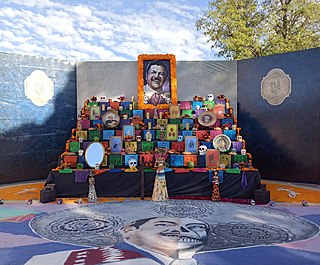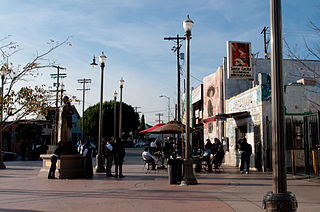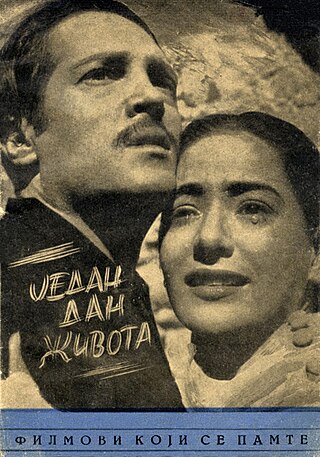
The music of Mexico is highly diverse, featuring a wide range of musical genres and performance styles. It has been influenced by a variety of cultures, primarily deriving from Europeans, Indigenous, and Africans. Music became an expression of Mexican nationalism starting in the nineteenth century.

Mariachi is an ensemble of musicians that typically play ranchera, the regional Mexican music dating back to at least the 18th century, evolving over time in the countryside of various regions of western Mexico. The usual mariachi group today consists of as many as eight violins, two trumpets and at least one guitar, including a high-pitched Mexican Vihuela and an acoustic bass guitar called a guitarrón, and all players taking turns singing lead and doing backup vocals.

José Alfredo Jiménez Sandoval was a Mexican singer-songwriter, whose songs are regarded as the basis of modern Regional Mexican music and Rancheras.

Miha Mazzini is a Slovenian writer, screenwriter and film director with thirty published books, translated in ten languages. He has a PhD in anthropology from the Institutum Studiorum Humanitatis and has MA in Creative Writing for Film and Television at the University of Sheffield. He is a voting member of the European Film Academy.

Vicente Fernández Gómez was a Mexican mariachi singer, actor and film producer. Nicknamed "Chente", "El Charro de Huentitán", "El Ídolo de México", and "El Rey de la Música Ranchera", Fernández started his career as a busker, and went on to become a cultural icon, having recorded more than 100 albums and contributing to more than 30 films. His repertoire consisted of rancheras and other Mexican classics such as waltzes.

María de los Ángeles de las Heras Ortiz, better known as Rocío Dúrcal, was a Spanish singer and actress with a career spanning more than four decades. She performed pop music, bolero, mariachi and romantic ballads and is widely regarded as one of the greatest Spanish singers of all time. Popular across Mexico and Latin America, she earned the sobriquet of Reina de las Rancheras.
Regional Mexican music refers collectively to the regional subgenres of the country music of Mexico and its derivatives from the Southwestern United States. Each subgenre is representative of a certain region and its popularity also varies by regions. Subgenres include banda, country en Español, Duranguense, grupero, mariachi, New Mexico music, Norteño, Sierreño, Tejano, and Tierra Caliente. It is among the most popular radio formats targeting Mexican Americans in the United States.

María Lucila "Lola" Beltrán Ruiz was a Mexican actress and singer.
The Golden Age of Mexican Cinema is considered to have spanned from 1936 to 1969 and was marked by the production of high-quality films that shaped Mexican national identity and culture. Films such as Los Olvidados by Luis Buñuel explored Mexico's social realities and left a lasting impact on audiences, both domestically, and internationally.

Miguel Aceves Mejía was a Mexican actor, composer and singer.

Mariachi Plaza is a plaza located in the Boyle Heights district of the city of Los Angeles, California. The plaza is known for its history as a center for mariachi music. Since the 1950s, mariachi musicians have gathered there in the hopes of being hired by visitors who are looking for a full band, trio, or solo singer. The plaza resembles Mexico's famed Plaza Garibaldi both in form and function, and it also serves as a historic gateway to the neighborhood.

King of the Rattling Spirits is a novel by Miha Mazzini. It was first published in Slovenia in 2001, with a second edition in 2008 and third edition in 2011, under the title of 'Kralj ropotajočih duhov'. The author has explored other ways to tell the fictionalized autobiographic story before the novel. Those included short story published in 1995 as illustrated text in Ars Vivendi magazin, and years later a screenplay for his film Sweet Dreams that won several awards at different film festivals in 2001. The novel was selected as one of 100 books to read from Eastern Europe and Central Asia by Calvert Journal.
Graciela Beltrán is a Mexican-American singer. She began singing in the Los Angeles area at the age of six at restaurants and parties. According to MTV she is "widely known as one of regional Mexican music's most influential female voices. Beltran is credited with helping to form the genre, as well as solidifying a woman's place in it."

Mexico and Yugoslavia established diplomatic relations on 24 May 1946 on the initiative of the President of Yugoslavia Josip Broz Tito. Both countries shared their views on Francoist Spain and cooperated with the Spanish Republican government in exile. On 31 July 1952 the two countries protested strongly against a decision of a United Nations committee to ask the Franco Government what it might be able to do to strengthen the collective security.

Guillermina Jiménez Chabolla known professionally as Flor Silvestre, was a Mexican singer and actress. She was one of the most prominent and successful performers of Mexican and Latin American music, and was a star of classic Mexican films during the Golden Age of Mexican cinema. Her more than 70-year career included stage productions, radio programs, records, films, television programs, comics and rodeo shows.

The nations of Croatia and Mexico established diplomatic missions in 1992. Both countries are mutual members of the United Nations.
"Allá en el Rancho Grande" is a Mexican song. It was written in the 1920s for a musical theatrical work, but now is most commonly associated with the eponymous 1936 Mexican motion picture Allá en el Rancho Grande, in which it was sung by renowned actor and singer Tito Guízar and with mariachis.

Ángela Aguilar Álvarez Alcalá is a Mexican and American singer. She was born in Los Angeles while her mother was accompanying her father, Pepe Aguilar, on tour. Aguilar gained notable recognition after performing "La Llorona" at the 19th Annual Latin Grammy Awards in 2018. Her paternal grandparents are the actors and singers from the Golden Age of Mexican cinema, Antonio Aguilar and Flor Silvestre.

Un día de vida is a 1950 Mexican melodrama film directed by Emilio Fernández. Set during the Mexican Revolution, it stars Columba Domínguez as Belén Martí, a Cuban journalist, and Roberto Cañedo as Colonel Lucio Reyes, a Mexican military officer sentenced to death.
Felipe Valdés Leal was a Mexican composer, lyricist, and artistic director. Valdés Leal grew up enjoying ranchera music and in 1923, he relocated to Los Angeles, California to pursue a career in music. He worked at a record store, where he would engage in humming, subsequently transcribing lyrical content to accompany them. His first successful compositions were the whimsical track "Échale un Quinto al Piano" and "Lucio Vázquez", a recording that garnered particular acclaim among the Latino community. By 1925, Valdés Leal became the artistic director at Brunswick Records, a pivotal role he played in catapulting the careers of Javier Solís, Irma Serrano, Los Panchos, and Los Alegres de Terán. In 1947, he became the artistic director for CBS Records.















